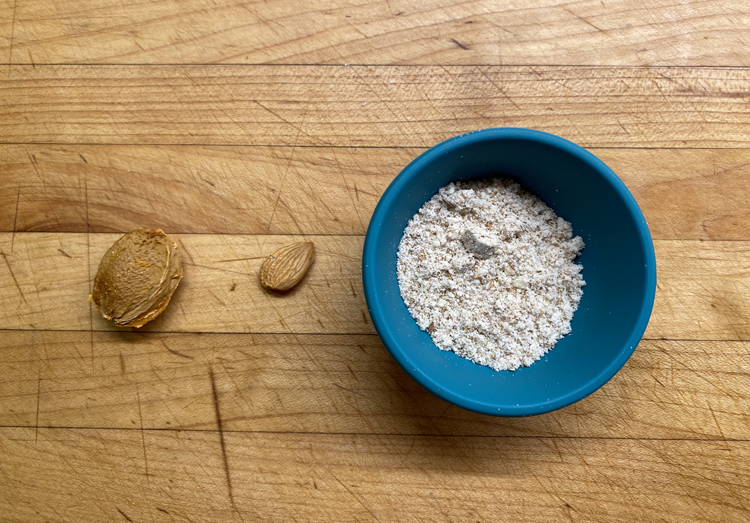Getting to the heart of it
July 6, 2025 by DarcieAfter I learned a few years ago that Italian amaretti are traditionally made with apricot kernels, I thought it would be fun to make them someday. Recently I bought apricots and decided that someday was now. After using the fruit in a cake, I stashed the pits in a mason jar until I had enough time to tackle the project. I wondered how best to crack the pits open to extract the kernel. I tried the obvious utensil first – a nutcracker. Apricot pits, I discovered, are extremely hard to crack. Maybe this is why I don’t know anyone who makes their own amaretti.

I managed to get a couple open but smashed my fingers in the process. In addition, when the pits cracked, shards flew all around the room. I then asked my husband to give it a go, surmising that with stronger hands, he would have better control over the process. Wrong. While it was easier for him to get them cracked, the pieces still went everywhere. It was time to try another method.
The heavy, cast iron Staub manual spice grinder seemed like an appropriate tool to smash the pits open while keeping the shards from scattering too much. It worked much better than the nutcracker, although a few pieces still managed to shoot across the counter. Finally, I got them all cracked open and had a handful of kernels, which looked like miniature almonds. I nibbled a tiny piece of one to see what it tasted like, and was amazed at the strength of the almond-like flavor.
Because raw apricot kernels contain amygdalin, a chemical that our bodies turn into cyanide once ingested, most authorities advise not to eat them raw. Apricot kernels are often touted as a health food and they have been used to make baked goods, herbal medicines, and liqueurs for centuries, which may seem to be at odds with this recommendation. However, processing the kernels by grinding or heating reduces the amount of amygdalin, rendering products like cookies or liqueurs safe for consumption.
After grinding the kernels to a fine powder, I had a small amount to use. With the work involved in getting to this point, I can tell this is going to be one of those experiments where I try it just once. Now it was time to find a recipe. I was surprised to see more than 130 recipes in the EYB Library that called for apricot kernels. I was looking for amaretti recipes in particular, and was delighted to find one on my bookshelf, Amaretti from Giuseppe’s Italian Bakes by GBBO winner Giuseppe Dell’Anno. Unfortunately, by the time I tracked down the recipe it was too late to bake. I’ll provides the results tomorrow in my weekly antipasto post.
Categories
- All Posts (7082)
- Antipasto (2211)
- Author Articles (250)
- Book News (944)
- Cookbook Giveaways (996)
- Cookbook Lovers (262)
- Cooking Tips (116)
- Culinary News (300)
- Food Biz People (558)
- Food Online (800)
- Holidays & Celebrations (277)
- New Cookbooks (154)
- Recipes (1520)
- Shelf Life With Susie (231)
- What's New on EYB (134)
Archives
Latest Comments
- Polyglutton on Any way you slice it
- FuzzyChef on Getting to the heart of it
- CordovaBayCook on For the Love of Lemons by Letitia Clark – Giveaway
- demomcook on Getting to the heart of it
- Ganga108 on Getting to the heart of it
- emi10383 on French at Heart – Cookbook Giveaway
- emi10383 on 20 Amici – 40 Ricette Cookbook Giveaway
- emi10383 on For the Love of Lemons by Letitia Clark – Giveaway
- emi10383 on Balli Balli – Cookbook Giveaway and Quick Bites
- Binguy on 20 Amici – 40 Ricette Cookbook Giveaway